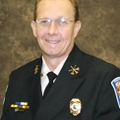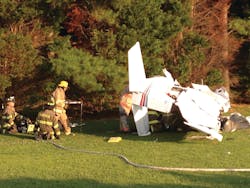On The Job Virginia: Middlesex County Plane Crash Results in Double Fatality
It appeared the 2014 Independence Day weekend was going to pass by Middlesex County, VA, with no critical issues. Hurricane Arthur moved due east of the county, clearing the way for a fun holiday weekend. Our quiet waterfront community always gets crazy in the summer, as the population doubles in size with boaters, campers and weekend residents. Unfortunately, the weekend would not end peacefully for the community’s first responders.
Middlesex County measures 131 square miles, with 134 miles of shoreline. The county has 10,800 permanent residents and 20,000 weekend and holiday visitors. It also has the second-largest boating population in Virginia. Emergency services are provided by four volunteer fire departments – Deltaville (Chief Jimmy Walden), Hartfield (Chief Alan Blake), Urbanna (Chief Ray Burch Jr.) and Water View (Chief Billy Collier) – and two volunteer rescue squads – Deltaville (Captain Dennis Mann) and Urbanna (Captain Kevin Mounts) – in addition to the author as emergency services coordinator and Emergency Management Director/Board Member Bob LeBoeuf.
As Sunday was winding down, the combined memberships of the Hartfield Volunteer Fire Department and the Middlesex Volunteer Rescue Squad’s training and response would be put to the test. On the evening of July 6, 2014, at approximately 4:40 P.M., a small Cessna 150 aircraft left Hummel Field in Middlesex County and crashed in a grassy area, less than a mile from the runway. Blake, chief of the Hartfield Volunteer Fire Department, arrived at the crash scene in less than three minutes. His initial actions set the stage in bringing together a combined emergency response of local, state and federal resources who worked collaboratively for the next 72 hours to effectively manage the aircraft incident.
Initial operations
Fire apparatus and rescue units arrived shortly after Blake to find a partially ejected female passenger being removed from the wreckage by several civilians. A second patient was still entwined in the wreckage. To complicate matters, the badly damaged aircraft also had a significant fuel leak. The initial patient was treated immediately by members of the Middlesex Volunteer Rescue Squad and transported to the county airport, allowing them to be flown to a local trauma center by LifeEvac3, an Air Methods Medivac Helicopter, based at Middle Peninsula Regional Airport in Mattaponi, VA.
Captain Dennis Mann of the Middlesex Volunteer Rescue Squad, the attendant-in-charge, credits his crew with providing life-saving measures to the ejected patient. Unfortunately, due to the extensive injuries suffered in the crash, this patient died in the hospital later in the evening. As this incident was unfolding, members of the Middlesex County Sheriff’s Office immediately established a security perimeter for the emergency scene to allow for the safety of the first responders as well as an extremely large response of outside agencies.
Initial fire crews immediately provided hazard protection lines as members of the rescue squad and fire department assessed the second patient, still trapped in the aircraft. Unfortunately, this individual was declared deceased on the scene by first responders and left in place pending the initial investigation. Fire Department members remained on scene for several hours to assist with hazard protection for the investigators.
Later in the evening and after clearance from the Federal Aviation Administration (FAA) representative on scene and the State Medical Examiner’s Office, the deceased patient was removed by members of the Hartfield Volunteer Fire Department. This extensive extrication operation was made more difficult from a safety perspective, as responders were dealing with a steady fuel leak from one of the wing fuel tanks, compromised by the aircraft’s electrical system still functioning. Due to the angle of the crash impact, the battery and the plane’s engine was partially buried in the earth and not readily accessible to the firefighters, making it impossible to immediately disconnect.
Once the victim was removed, the incident commander, working with initial investigators from the FAA, made a safety decision to leave the scene intact and wait until the following morning to remove the battery. We knew representatives from the aircraft manufacturer and the engine manufacturer would be on scene the following morning. We would utilize their technical knowledge and expertise in directing us in the safest means to disconnect the power the following morning. This prompted our decision to secure the area, treat it as a crime scene and return the following morning to complete the task of completely securing the scene for the investigation. None of the first responders had been injured while performing their duties in what was a very hazardous atmosphere; we would not risk an injury with nothing to gain.
Middlesex County Administrator Matt Walker and Board of Supervisors Chairman Jack Miller responded to the scene to ensure the responders had all the resources required to safely handle the emergency. They both praised the first responders for their prompt response and emergency efforts as they collectively worked to bring a volatile situation under control.
The last function we dealt with after the initial emergency was stabilized was the significant media presence arriving on the scene. Middlesex County is situated between two major Virginia media markets – Richmond and Hampton Roads. Normally, media coverage is non-existent in our community, which was not the case on this night. Working with Blake in my role as the county emergency services coordinator, I advised the media on the actions taken by the members of the Hartfield Volunteer Fire Department and the Deltaville Volunteer Rescue Squad through interviews with five TV stations and two newspapers. The information was cleared before release with Middlesex County Sheriff David Bushey and Virginia State Police Sergeant Scott Edelman to ensure it would not interfere with the unfolding crash investigation. All interviews completed covered only the fire and EMS aspects of the incident and did not speak to the cause of the accident or identities of the patients.
The following morning, an initial incident briefing was held, attended by Bushey, Edelman and myself along with representatives from the FAA, National Transportation Safety Board (NTSB), Cessna Corp. and the airplane engine’s manufacturer. The first order of business after the briefing was to assign a fire crew to assist with removing the battery from the aircraft. After this was completed, the scene was now safe for the investigators to begin their work. The investigation and subsequent removal of the aircraft lasted an additional three days after the crash. Additionally, the disturbed land had to be placed back into pre-crash condition, which included removing fuel-soaked soil. With this complete, the incident was deemed complete. A post-incident critique was performed at which all first responders and outside agencies discussed the incident and suggested improvements to ways in which our collective organizations will work together in the future.
Lessons learned
Incidents such as this can easily be defined as “low-frequency/high-risk” events that cause us our greatest challenges, particularly in regard to the safety of first responders. Fortunately, due to the proper decisions and command presence being utilized on the front end, this significant incident played out in our favor. With this known, I share observations and lessons learned that will be applied to future incidents in our jurisdiction and just as easily in yours:
• Stay with the basics and establish a strong command presence. Situational awareness of the entire incident scene is critical, as there are many hidden dangers in dealing with an aircraft incident. We secured the scene from a safety perspective immediately. When we determined the second patient was significantly trapped and declared deceased, we moved to a safe location and waited for investigators until we returned to the hot zone.
• Utilize a unified command structure. This is critical to managing scenes with a heavy presence of fire, EMS and law enforcement organizations. Develop partnerships with local and state law enforcement organizations well before an incident occurs. Many emergency service organizations, including those in Middlesex County, have already built these valuable relationships. The relationships you build now will pay dividends into the future.
• Establish a liaison-officer position early into the incident. The magnitude of such an event brings out a wide spectrum of outside agencies that are critical to a successful outcome. In this incident, the incident commander worked with the Middlesex Sheriff’s Office, Virginia State Police, Virginia State Medical Examiner, Virginia Department of Emergency Management, a local trauma center, LifeEvac3, medical transport, FAA, NTSB, the aircraft and engine manufacturers, the airplane insurance company, the land owner, an airplane removal company, a private security company and a hazardous materials clean-up company. Being able to provide for these individuals and ensuring they work in concert with one another and your jurisdiction will be critical to a smooth operation.
• Establish a public information officer (PIO) position and media staging area early into the event. Our community is very small and situated between two major media markets that will come out for an airplane crash. Coordinate all efforts with local and state law enforcement agencies on the scene. Ensure you keep your comments focused on fire and EMS operations and do not discuss the cause of the crash or the identities or gender of the victims.
• Keep your government leaders well informed. After delivering an initial report of the incident, the Board of Supervisors and county leadership team members were given briefing updates twice each day throughout the event. It is critical to have government leaders at the scene to get first-hand experience of the actual work performed by your community’s first responders. Make accommodation on the scene for these individuals and have a dedicated member prepared to brief them on the current and future status of the incident.
• Ensure the well-being of your members after the incident. Make a conscious decision to identify the need for and utilize critical incident stress debriefings (CISDs) for your members. This should be done immediately following, as well as downstream from the incident, until you know your members have fully recovered.
• Plan a post-incident critique as soon after the event as feasible. Review and reinforce the positive aspects of the event, discuss improvements and to make any policy/procedural changes, additions, deletions and corrections that will be beneficial to future “low-frequency/high-risk” incidents which will eventually occur in your community.
HARTFIELD VOLUNTEER FIRE DEPARTMENT
Chief: Alan Blake
Personnel: 35 volunteer firefighters
Apparatus: 1 engine, 1 rescue engine, 2 tankers, 1 brush truck
Population: 2,600
Area: 32 square miles
MIDDLESEX VOLUNTEER RESCUE SQUAD
Captain: Dennis Mann
Personnel: 25 BLS volunteers, 12 ALS volunteers
Apparatus: 5 medic units, 2 quick response vehicles, 1 MCI response unit
Population: 5,600
Area: 76 square miles
About the Author

Mark Nugent
Battalion Chief
MARK R. NUGENT is the emergency services coordinator for Middlesex County, VA. He works with a dedicated organization of volunteer Fire and EMS responders, who provide all-hazards response in the waterfront community of Middlesex, and also is the emergency manager for the county. Chief Nugent has an associate’s degree in fire science, an associate’s degree in emergency medical services and a bachelor’s degree in organizational management and development. Chief Nugent lectures on the local and national levels and is co-author of the book and website The Community Fire Safety Operational Guide. Follow him on Twitter: @chiefnugent
